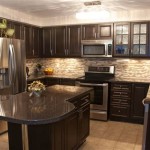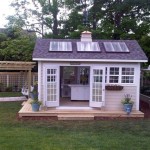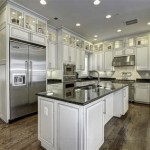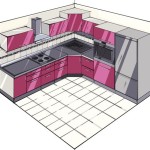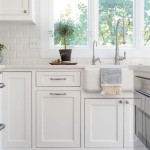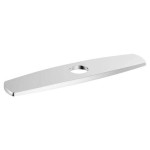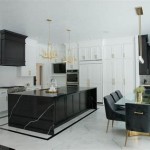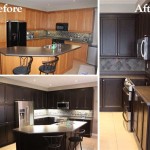Two-Toned Cabinets: A Guide to Kitchen Design
Two-toned cabinets have emerged as a prominent design trend in kitchen remodeling, offering a visually dynamic and personalized approach to cabinetry. This design strategy involves using two distinct colors or finishes on different sets of cabinets within the same kitchen space. This approach allows for greater flexibility in design, enabling homeowners to create a unique and customized kitchen environment. The contrast adds depth, dimension, and personality to the space, moving away from the sometimes-monotonous look of a single-tone kitchen.
Two-toned cabinets are not merely a stylistic choice; they are a calculated design decision that can significantly impact the overall aesthetic and functionality of the kitchen. The careful selection of colors, cabinet placement, and hardware contributes to creating a harmonious and visually appealing space. The trend offers endless possibilities, catering to various design preferences, from modern and minimalist to traditional and rustic. The success of this design relies heavily on understanding the principles of color theory, spatial awareness, and the impact of lighting on the chosen colors.
Key Considerations Before Implementing Two-Toned Cabinets
Before embarking on a two-toned cabinet design, it is crucial to consider several key factors that will influence the final outcome. These considerations include the size and layout of the kitchen, the existing architectural style, the desired aesthetic, and the overall budget.
Kitchen Size and Layout: The size of the kitchen plays a crucial role in determining the suitability of two-toned cabinets. In smaller kitchens, it is generally advisable to use a lighter color for the upper cabinets to create an illusion of height and spaciousness. Darker colors can be used for the lower cabinets to ground the space and add visual weight. In larger kitchens, the color palette can be more diverse, allowing for bolder contrasts and more elaborate designs. The layout of the kitchen also influences cabinet placement. For instance, in a galley kitchen, a lighter color on one side of the cabinets can help visually widen the space.
Architectural Style: The architectural style of the home should also be considered when selecting colors for two-toned cabinets. In a modern home, sleek, minimalist cabinets with contrasting colors such as white and gray or black and white may be appropriate. In a traditional home, warmer tones such as creams, beiges, and browns may be more suitable. The chosen colors should complement the existing architectural elements, such as the flooring, countertops, and backsplash.
Desired Aesthetic: The overall aesthetic that the homeowner wishes to achieve should be the primary driver of the design. A modern aesthetic might call for high-gloss finishes and clean lines, while a rustic aesthetic might incorporate distressed finishes and natural wood tones. The choice of colors should reflect the desired mood and atmosphere. For instance, cool colors such as blues and greens can create a calming and serene environment, while warm colors such as reds and oranges can add energy and vibrancy.
Budget: The budget will also influence the selection of materials and finishes for the cabinets. Custom cabinets tend to be more expensive than stock cabinets, but they offer greater flexibility in terms of design and color options. The cost of painting or refinishing existing cabinets should also be considered. It is advisable to obtain multiple quotes from different contractors to ensure that the project stays within budget.
Popular Color Combinations for Two-Toned Cabinets
The success of a two-toned cabinet design hinges on selecting the right color combinations. Some colors complement each other, creating a harmonious and balanced look, while others may clash, resulting in a visually disjointed space. Several popular color combinations have consistently proven successful in kitchen design.
White and Gray: White and gray is a classic and versatile combination that works well in a variety of kitchen styles. White cabinets, typically used for uppers, create a bright and airy feel, while gray cabinets, often used for lowers or islands, add depth and sophistication. This combination is particularly well-suited for modern and contemporary kitchens. The shade of gray can be customized to suit the homeowner's preferences, ranging from light and airy to dark and dramatic.
White and Wood Tones: Combining white cabinets with natural wood tones is another popular choice, particularly for transitional and farmhouse-style kitchens. The white cabinets provide a clean and neutral backdrop, while the wood tones add warmth and texture. This combination can be achieved by using wood cabinets for the base cabinets or the kitchen island, or by incorporating wood accents on the upper cabinets. Different wood species, such as oak, maple, and walnut, can be used to achieve varying degrees of warmth and richness.
Blue and White: Blue and white is a refreshing and timeless combination that evokes a sense of coastal charm. Blue cabinets, in shades ranging from navy to pastel, can be used for the lower cabinets or the kitchen island, while white cabinets are used for the upper cabinets. This combination works well in both traditional and contemporary kitchens. The specific shade of blue can be adjusted to create different moods, with lighter blues creating a more airy and casual feel, and darker blues creating a more sophisticated and elegant feel.
Black and White: Black and white is a bold and dramatic combination that creates a striking visual contrast. Black cabinets, typically used for the lower cabinets or the kitchen island, add a sense of sophistication and grounding, while white cabinets provide a clean and bright contrast. This combination is particularly well-suited for modern and minimalist kitchens. The use of black and white can be softened by incorporating natural elements such as wood or stone.
Green and White/Wood: Green is a revitalizing and natural color that can bring a touch of the outdoors into the kitchen. Green cabinets, in shades ranging from sage to emerald, can be paired with white or wood cabinets to create a harmonious and balanced look. This combination works well in both traditional and contemporary kitchens, adding a touch of freshness and tranquility to the space. Green can be used on either upper or lower cabinets, depending on the desired effect.
Placement and Design Strategies for Optimal Effect
The placement and design of two-toned cabinets are critical to achieving the desired visual impact. The careful consideration of cabinet placement, hardware selection, and the integration of other design elements can significantly enhance the overall aesthetic of the kitchen.
Upper vs. Lower Cabinets: A common strategy is to use a lighter color for the upper cabinets and a darker color for the lower cabinets. This approach helps create a sense of height and spaciousness, particularly in smaller kitchens. The lighter upper cabinets reflect light, making the kitchen feel brighter and more open, while the darker lower cabinets ground the space and add visual weight. The proportions should be carefully considered to ensure a balanced look. For instance, if the upper cabinets are significantly taller than the lower cabinets, the contrast may need to be less dramatic to avoid a top-heavy appearance.
Island Distinction: Using a different color for the kitchen island is a popular way to create a focal point and add visual interest to the space. The island can be painted in a contrasting color to the surrounding cabinets, or it can be finished in a different material, such as wood or metal. The size and style of the island should be considered when selecting the color. A large island may benefit from a darker color to ground it, while a smaller island may benefit from a lighter color to make it feel more expansive. The island can also incorporate other design elements, such as a contrasting countertop or backsplash, to further enhance its visual appeal.
Accent Cabinets: Introducing accent cabinets in a different color or finish can add a touch of personality and visual intrigue to the kitchen. Accent cabinets can be used strategically to highlight specific areas, such as the pantry or the range hood. They can also be used to create a focal point, such as a display cabinet with glass doors. The color of the accent cabinets should complement the other colors in the kitchen and should be used sparingly to avoid overwhelming the space. The placement of accent cabinets should be carefully considered to ensure that they are visually balanced and do not disrupt the flow of the kitchen.
Hardware Considerations: The hardware selected for the cabinets plays a crucial role in complementing the two-toned design. The finish and style of the hardware should harmonize with the colors and materials of the cabinets and other design elements. For instance, brushed nickel hardware may complement light gray cabinets, while oil-rubbed bronze hardware may complement dark wood cabinets. The size and shape of the hardware should also be proportional to the size and style of the cabinets. The hardware can be used to create a cohesive look throughout the kitchen or to add a touch of contrast and visual interest. For instance, using different hardware styles on the upper and lower cabinets can create a subtle but effective distinction.
Lighting Integration: Lighting plays a vital role in showcasing the colors of two-toned cabinets. Strategically placed lighting can enhance the contrast between the two colors and create a more visually appealing space. Under-cabinet lighting can highlight the countertop and backsplash, while pendant lighting can illuminate the kitchen island. The color temperature of the light should also be considered. Warm lighting can enhance the warmth of wood tones, while cool lighting can accentuate the coolness of gray and blue tones. The lighting should be adjustable to allow for different moods and activities. Dimmers can be used to create a more intimate and relaxing atmosphere, while brighter lights can be used for tasks such as cooking and cleaning.
By carefully considering these elements, homeowners can effectively implement two-toned cabinets to create a kitchen that is both stylish and functional. The strategic use of color and design can transform an ordinary kitchen into a visually captivating and personalized space.

18 Examples Of Two Toned Kitchen Cabinets From Designers
:strip_icc()/cdn.cliqueinc.com__cache__posts__250323__two-toned-kitchen-cabinets-250323-1519416360278-main.700x0c-053dda2f27cc41c18d2f5d3aaef8660b-22a98f743a9e480ab9869a2e5cf6d3a0.jpg?strip=all)
30 Stylish Two Toned Kitchen Ideas From An Expert

Design Inspiration Tips For Two Tone Kitchen Cabinets Hirshfield S

20 Two Toned Kitchen Cabinet Ideas Hgtv

26 Two Tone Kitchen Cabinet Ideas That Make A Dazzling Duo

Using Color For Eye Catching Two Tone Kitchen Cabinets
:strip_icc()/goldalamodetwotoned-7898e45ce4004aec878721b187b98301.jpeg?strip=all)
30 Stylish Two Toned Kitchen Ideas From An Expert

26 Two Tone Kitchen Cabinet Ideas That Make A Dazzling Duo

Shw Home Decor Furniture Gardening Diy Craft Ideas

A Beginner S Guide To Two Toned Kitchen Cabinets Wc Supply Wholesale Cabinet

